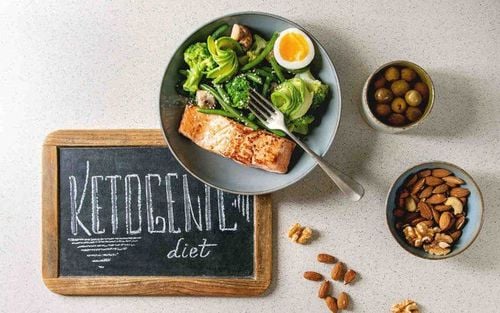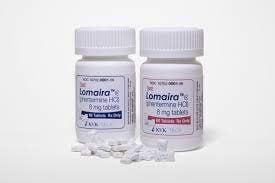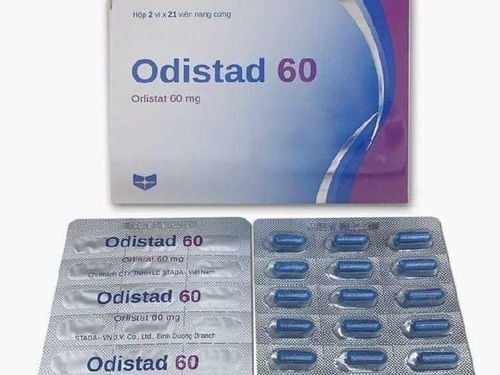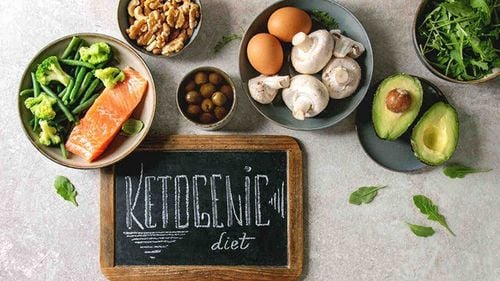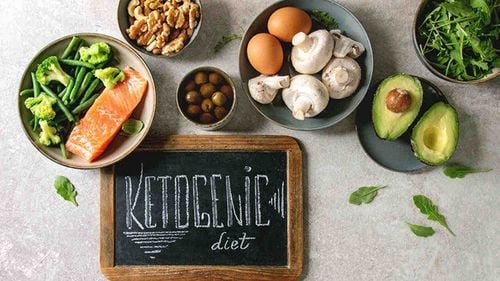This is an automatically translated article.
Posted by Master, Doctor Mai Vien Phuong - Department of Examination & Internal Medicine - Vinmec Central Park International General Hospital
The Ketogenic diet is a diet low in carbohydrates and high in good fats. By this diet, it will help our body burn more energy without having to go on a strict diet.
1. What is the Ketogenic Diet?
Ketogenic diet has become extremely popular nowadays. Early research suggests that this high-fat, very-low-carbohydrate diet may be beneficial for certain health conditions.
Keto diet (Ketogenic) is a diet low in carbohydrates (carbs) and high in good fats. The Keto menu helps the body burn more energy without the need for strict diets.
When you regularly cut carbs in your diet, your body will enter a state of "Ketosis". At this time, the body increases energy burning. At the same time, the pancreas will also convert fats into ketones, providing energy for the brain. The Ketogenic diet can significantly lower blood sugar and insulin levels, affect the body's metabolism, and limit fat storage. This can bring a lot of benefits to your health.
MORE: Does the Keto diet work for weight loss?
2. Sample Keto menu for a day
This sample Keto diet is a good example of a day of the Keto diet. You can rely on the basic principles of this diet to design your daily menu.
Breakfast: 2 fried eggs with olive or avocado oil, 1 slice of salmon. Mid-morning snack: Almonds or cashews. Lunch: Chicken breast, bell pepper, mixed vegetables with oil. Mid-afternoon: Cheese Dinner: Beef, vegetables, mushrooms. As with any Keto diet, persistence is also an important factor for beginners to achieve the highest possible results. In addition, you should also not forget to combine exercise and reasonable rest with nutrition to maintain a healthy body.

3. Different Types of Ketogenic Diets
There are several versions of the ketogenic diet including:
Standard ketogenic diet (SKD): This is a very low carb, moderate protein and high fat diet. It usually contains 70% fat, 20% protein and only 10% carbs. Cyclic ketogenic diet (CKD): This diet includes periods of higher carb intake, such as 5 ketogenic days followed by 2 high carb days. Targeted Ketogenic Diet (TKD): This diet allows you to add carbs around your workouts. High-protein ketogenic diet: This is similar to the standard ketogenic diet, but includes more protein. The ratio is usually 60% fat, 35% protein, and 5% carbs. However, only the standard and high-protein ketogenic diet has been extensively studied. Cyclic or targeted ketogenic diets are more advanced methods and are mainly used by bodybuilders or athletes.
If you want to try the ketogenic diet, follow these basic rules:
Eliminate carbohydrates: Check food labels and aim for 20 to 50 grams of carbohydrate hydrate or less per day Stock up staples: Buy meat, cheese, whole eggs, nuts, oils, butter, oily fish and cream,... These are the staples of your diet. Eat more vegetables: Fat sources are high in calories, so base each meal with low-carbohydrate vegetables to fill your plate and help you feel full. Vegetables will also provide fiber that you will no longer get from whole grains, beans or legumes. Try new foods: A ketogenic diet can still be fun and delicious. You can even make ketogenic pasta, bread, muffins, macaroons, puddings, ice cream, and more. Build a plan: It can be difficult to find low-carbohydrate meals when you're busy. As with any diet, it's important to plan and go for a snack or meal. Find What You Like: Experiment until you find the optimal keto diet for you. Track progress: Take a picture, measure, and track your weight every 3 to 4 weeks. If there is no improvement, recheck your daily intake. Make sure you eat enough vegetables at each meal and keep portions moderate. Fluid replacement: Make sure you're drinking enough water and getting the right amount of electrolytes, like sodium, potassium, and magnesium. Be consistent: There are no shortcuts to success. With any diet, consistency is the most important factor. You can also monitor your urine or blood ketone levels, as these let you know if you're keeping enough carbohydrate levels to reach ketosis.
Before switching to this diet or using any dietary supplement, consult your doctor or dietitian.

4. Should You Try the Ketogenic Diet?
There is no single diet that is right for everyone, due to different metabolisms, genes, body types, lifestyles, taste buds and personal preferences.
It may be beneficial for people with obesity or those at higher risk of metabolic syndrome, but it is not suitable for everyone. For example, the Keto diet is not suitable for people with the following conditions:
Pancreatitis Liver failure Fat metabolism disorders Carnitine porphyrias deficiency Pyruvate kinase deficiency May also have some negative effects. When you first start the diet, you may experience flu-like symptoms, known as the “keto flu.”
This can include poor energy and mental function, increased hunger, sleep problems, nausea, digestive discomfort, and poor exercise performance.
Researchers have yet to do enough long-term investigations to figure out exactly what the long-term effects may be, but there may be a risk of kidney or liver problems.
There is also a risk of dehydration, so you need to drink plenty of fluids, especially water, when following this diet. Always talk to your doctor before starting a ketogenic diet to make sure it's safe and right for you.
The ketogenic diet can also be difficult to follow. If you can't follow it but still want to stick to a low-carbohydrate diet, then trying a standard low-carbohydrate diet might be a better option for you.
The ketogenic diet may also not be the best choice for elite athletes or those looking to build large amounts of muscle.
Also, people who are vegetarian or vegan may have difficulty with this diet because meat, eggs, fish and dairy play an important role.
Ketogenic diet can bring amazing results if you stick to it. However, it may not be the best option for everyone.
Conclusion:
To get the most out of the ketogenic diet, you must eat foods high in fat and limit your carbohydrate intake to less than 30–50 grams per day.
If you follow a ketogenic diet with medical supervision, it can help you lose weight and possibly boost your overall health. Keto can reduce the risk of type 2 diabetes, obesity, and other aspects of metabolic disease. Before starting any new diet, be sure to ask your doctor if it's the right option for you.
If you have a need for consultation and examination at Vinmec Hospitals under the nationwide health system, please book an appointment on the website for service.
Please dial HOTLINE for more information or register for an appointment HERE. Download MyVinmec app to make appointments faster and to manage your bookings easily.





